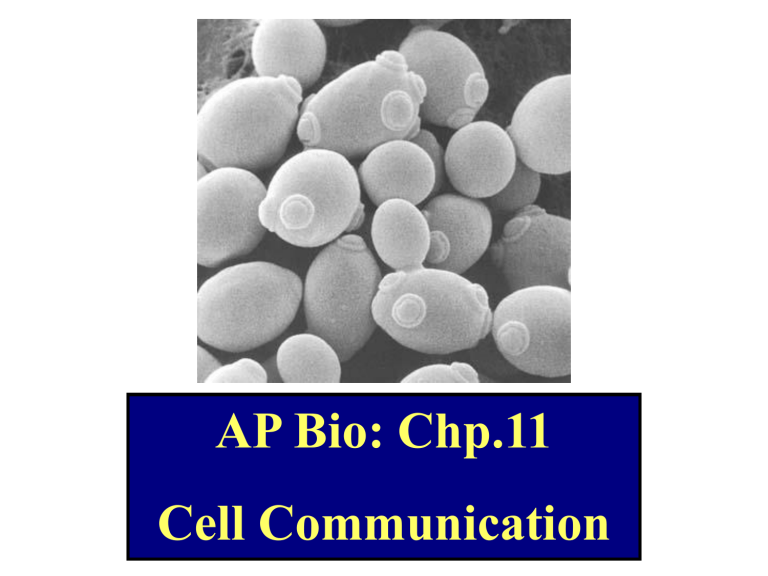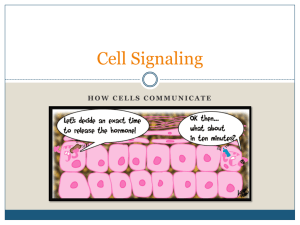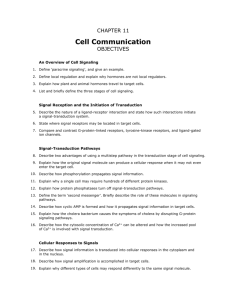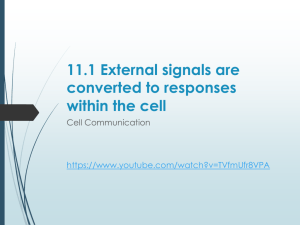a cells - My CCSD

AP Bio: Chp.11
Cell Communication
Cell-to-cell signaling :
•
Important to both multicellular & unicellular organisms.
•
Helps coordinate activities & events necessary for multicellular organism to develop from zygote into billion of cells.
•
Unicellular organisms - important in finding different mating types for sexual reproduction.
•
Example Yeast cells have 2 mating types- “a cells” & “α (alpha) cells”. Each type secretes a dif. chemical “factor” & each have receptor sites for each others factors.
•
These mating factors cause the cells to grow toward one another and bring about other changes.
•
Inside the cells there are a series of chemical changes, called the signal-transduction pathway , that cause the response.
•
The new a/alpha cell has all the genes from both the different haploid yeast cells.
•
These pathways are common to both humans and yeast cells suggesting that this strategy evolved very early on.
Which of the following is true about type a and type a cells?
A) Only type a cells have receptor sites
B) Only type a cells have receptor sites
C) Only type a cells produce mating factors
D) Only type a cells produce mating factors
E) Both types of cells produce mating factors and has receptors sites for the other’s mating factor
E
This is signaling between two different mating types of yeast cells. Each one produces a mating factor for the other and each one has a receptor site for the others mating factor.
Cell Signaling in Bacteria Example: Quorum Sensing
•
Bacteria cells secrete small molecules that are detected by other cells
•
Concentration of signaling molecules causes bacteria to aggregate and coordinate their behaviors
•
Biofilm = an aggregation of bacterial cells to a surface
•
Examples: Slimy coating on a fallen log, Coating on your teeth in the morning
Which of the following provides the best evidence that cell-signaling pathways evolved early in the history of life?
A) They are seen in "primitive" cells such as yeast.
B) Yeast cells signal each other for mating.
C) Signal transduction molecules found in distantly related organisms are similar.
D) Signals can be sent long distances by cells.
E) Most signals are received by cell surface receptors.
C
If distantly related organisms have the same or closely related proteins, that indicates that the biochemical pathway has been around for a great deal of time. One example of this is glycolysis.
Communication between cells can be:
1. Local signaling (very close)
Examples: Direct Contact
Paracrine Signaling
Synaptic Signaling
2. Long-Distance signaling (some distance away)
Examples: Endocrine (hormonal) signaling
Direct contact- Cells have cell junctions where direct contact of the cytoplasms of adjacent cells occur. This allows for signaling substances in the cytosol to pass freely between the adjacent cells.
Animals cells can communicate via direct contact between molecule on their surface of their cell membranes. This is common in embryonic development and the immune system (secretion of interleukin when macrophage and virgin-T cell make a match).
Local signaling Example 1:
•
Paracrine signaling
• in animals
•
Cell secretes a chemical that acts on nearby target cells.
•
Example = Cells may release a growth factor that causes surrounding cells to grow & multiply.
Local signaling Example 2:
•
Synaptic signaling
•
Neurons secrete neurotransmitters that diffuse across an intercellular space
(synapse) & interacts with a another neuron.
Note - Local signaling in plants is not as well understood because of the plant cell wall, plant must use a different mechanism than those operating in animals.
This diagram is an example of
A) hormonal signaling
B) Paracrine signaling
C) long distance signaling
D) pheromonal signaling
B
The secretory cell and the receptor cells are close to one another which makes this an example of paracrine signaling.
Long-distance signaling:
•
Uses hormones (chemicals secreted by one cell but exerts effect on another cell some distance away).
•
In animals the hormone is released into the vessels of circulatory system and the molecules travel to target cells.
•
In plant cells, hormones may travel in vessels or diffuse into the air as a gas.
•
Hormones may vary in their size and molecular structure.
Types of Animal Hormones:
1. Modified amino acids –
• ex. epinephrine is a modified tyrosine.
2. Proteins –
• ex. insulin is a large protein
3. Steroid Hormones –
• ex. testosterone and estrogen
4. Pheromones
• chemicals secreted by one animal to affect the behavior of another animal.
This is an example of
A) hormonal signaling
B) paracrine signaling
C) short distance signaling
D) neuron signaling
A
This is a signal that travels through the blood stream some distance away. That is the definition of hormonal signaling. Paracrine signaling and neuron signaling is signaling at close proximity.
The three stages of cell signaling are
1. Reception
2. Transduction
3. Response
Which of the following is the plant equivalent to gap junctions?
A) tight junctions
B) desmosomes
C) receptor junctions
D) plasmodesmata
D
The plasmodesmata is analogous to the gap junctions found in animal cells. They both allow for communication between cells through the cytoplasm.
1. Reception
-
• begins with the signal interacting with a receptor site located on the outside surface of the plasma membrane
•
Usually the signal is a ligand (a small molecule that attaches to a large one).
•
When the ligand attaches it causes a change in shape of the receptor site.
•
Receptors are usually proteins inserted into the plasma membrane.
***Note ligands in cell communication can be hormones, neurotransmitters, or growth factor, or something similar.
The correct sequence of events for this pathway is
A) reception->response -> transduction
B) reception->transduction->response
C) transduction->response->reception
D) transduction->reception->response
E) response->transduction->reception
B
The correct sequence of events is
1. reception
2. transduction (usually some sort of cascading pathway)
3. some sort of end response.
Three major types of membrane receptors are: a. G-protein-linked receptors b. tyrosine-kinase receptors c. ion-channel receptors a. G-protein-linked receptors vary in their binding sites and for recognizing different G-proteins. Most have seven alpha helices penetrating the plasma membrane.
When a G-protein-linked receptor binds with a signal or ligand, it becomes activated and interacts with a Gprotein.
Stop day 1






